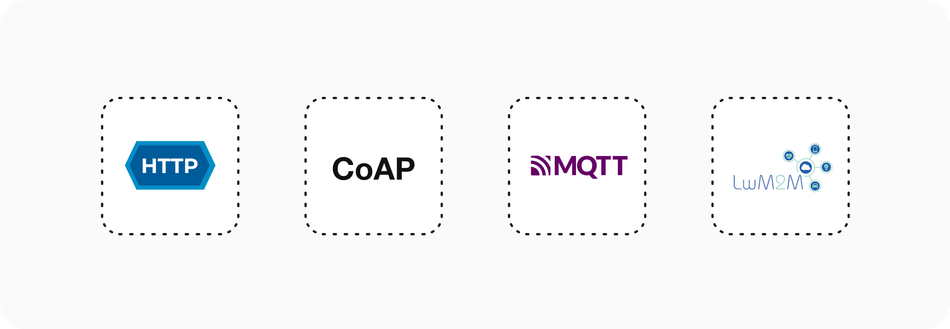Cellular IoT and its Features
Find out what cellular IoT is and how you can benefit from its features.
This article was first published on
akenza.ioAs the Internet of Things (IoT) continues to grow, more devices are being connected to the internet than ever before. One of the key technologies that has made this possible is cellular IoT, a group of protocols that allow physical devices to connect to the cloud via cellular networks.
So what exactly is cellular IoT?
Put simply, it's a way of connecting IoT devices to the internet using the same mobile networks as our smartphones. This means that devices using cellular IoT protocols come equipped with a SIM card that has a unique identifier. The network carrier uses this identifier to manage the devices in the network.
How SIM cards became the enabler of IoT
In the past, SIM cards could only hold one profile tied to a single service provider. This meant that if you wanted to switch to a different provider, you had to physically replace the SIM card. However, the introduction of the Embedded Universal Integrated Circuit Card (eUICC) has changed all that. With an eUICC, it's possible to switch service providers over-the-air without needing to physically change the embedded SIM card. This is a major improvement, as it simplifies the global deployment of cellular-based IoT solutions.
Once the devices are connected to the network, they transmit their data directly to a base station or cell tower. From there, the IoT data is accessible on the internet and can be viewed on your cloud platform.
So let’s take a look at how exactly the different cellular protocols come into play:
The most used cellular IoT networks
If you're looking to connect your IoT devices to the cloud via cellular networks, it's important to understand the two most popular cellular IoT technologies: LTE Cat-M1 (also known as LTE-M) and NB-IoT (narrowband IoT).
Both of these cellular protocols were developed to support IoT use cases and have their origins in the 4G LTE standard. They fall under the LPWAN (low-power wide area network) umbrella, but they have some distinct differences:
LTE-M specializes in the transfer of low to medium amounts of data, up to 1Mbps compared to the 66 kbps for NB-IoT (159 kbps for LTE Cat NB2). It is also low-cost and low-power, making it a good fit for many IoT use cases. Additionally, LTE-M supports cellular tower handoffs, making it well-suited for mobile applications. LTE-M also supports voice functionality via voice over LTE (VoLTE), which opens up opportunities for broader human-machine interactions. With higher data rates compared to NB-IoT, LTE-M is well-suited for use cases that involve a larger exchange of data at a lower latency, such as remote monitoring or asset tracking.
NB-IoT is designed to consume very little power, making it an ideal choice for battery-powered devices. It provides improved in-building coverage and is relatively cheap to implement. However, it is limited in terms of data bandwidth as it is constrained to a 180kHz narrowband. NB-IoT is best suited for cost-sensitive applications with minimal performance requirements. This protocol is ideal for IoT use cases that require small, intermittent data transmissions where latency is not a critical factor.
When it comes to global availability, LTE-M initially had an advantage as it is compatible with existing LTE networks, but this is slowly changing as more countries adopt NB-IoT infrastructure, which is cheaper to deploy.
However, if you're deploying devices in different regions of the world, you'll need to pay attention to roaming agreements. LTE-M already has cellular roaming agreements in place, while roaming for NB-IoT is comparatively limited.
The most common IoT data protocols for cellular IoT
When it comes to cellular IoT technologies, it's not just about how data is transmitted from devices to the cloud. We also need to look at how these technologies exchange information at the application level.
Commonly used IoT data protocols include HTTP, CoAP, MQTT, and Lightweight M2M (LwM2M). These protocols define how IoT devices exchange information and communicate on the Internet, ensuring secure and efficient data exchange.
HTTP (Hypertext Transfer Protocol) is a well-established protocol used for web applications, and it's also used for IoT applications where it provides a reliable way to transfer data. HTTP is designed to work with web servers, but it can also be used for IoT devices that have enough processing power to handle the protocol.
CoAP (Constrained Application Protocol) is a lightweight protocol designed specifically for IoT devices with limited processing power and low memory. It is used for low-latency communication and is ideal for devices that require real-time data exchange.
MQTT (Message Queuing Telemetry Transport) is a messaging protocol designed for IoT devices with limited bandwidth and intermittent connectivity. It enables devices to send and receive small packets of data, making it ideal for use cases where network bandwidth is limited.
LwM2M (Lightweight M2M) is a protocol that enables remote management and monitoring of IoT devices. It is designed for use cases where low power consumption and limited network bandwidth are a requirement. LwM2M provides efficient data transfer and supports firmware updates, configuration, and monitoring of devices.

Use cases for cellular IoT
Among the typical use cases of cellular IoT, we can mention:
Asset Tracking: Companies are using cellular IoT to track the location and status of their assets, such as shipping containers or vehicles.
Medical alert devices: Healthcare providers are using cellular IoT to remotely monitor patients and collect data on their health and well-being.
Smart city applications: Municipalities are using cellular IoT to manage traffic, monitor air quality, and optimize energy usage.
Smart agriculture: Farmers are using cellular IoT to monitor soil moisture, temperature, and other environmental factors to optimize crop yields.
Industrial automation: Manufacturers are using cellular IoT to monitor and control their machines, electricity, reducing downtime and improving productivity.
How does cellular IoT compare to LoRa?
As you can see, cellular IoT is a popular choice for IoT applications due to its broad existing cellular coverage, low-power requirements, and potential cost savings. However, how does it compare to another leading LPWAN technology, namely LoRaWAN?
Availability
One of the main differences between these two technologies is that cellular IoT operates in the licensed spectrum and is run by operators on the existing cellular infrastructure, benefiting from a broad coverage. LoRaWAN operates in the unlicensed spectrum and can be deployed virtually anywhere, including remote areas where cellular coverage is unavailable.
Data rates
Looking at data rates, cellular IoT typically reaches higher data rates and lower latency relative to LoRa technology. This makes cellular IoT better suited for applications that require the exchange of large amounts of data. LoRa technology, on the other hand, is better suited for applications that exchange minimal amounts of data.

Battery life
Both cellular IoT and LoRa technology have relatively low power requirements, but LoRa technology can support the longest battery life, with some devices running on battery for years. In contrast, cellular IoT devices may require more frequent battery replacements due to higher data transmission rates and power consumption.
Updates
Firmware updates are an essential part for a working and secure IoT solution. As LoRa supports a lower data rate than cellular IoT, it can become increasingly difficult to perform firmware updates through those networks.
Should you choose cellular IoT for your next IoT project?
It's important to note that both cellular IoT and LoRaWAN have their advantages and disadvantages, and neither technology is inherently better than the other. Ultimately, different protocols can even be deployed together in the same project to have the best of both worlds. The choice ultimately depends on your specific IoT use case.
Whether you are interested in launching an IoT project based on LoRaWAN or cellular IoT, the akenza platform can help you get started.
Start building your IoT project today. Try out akenza for free.

